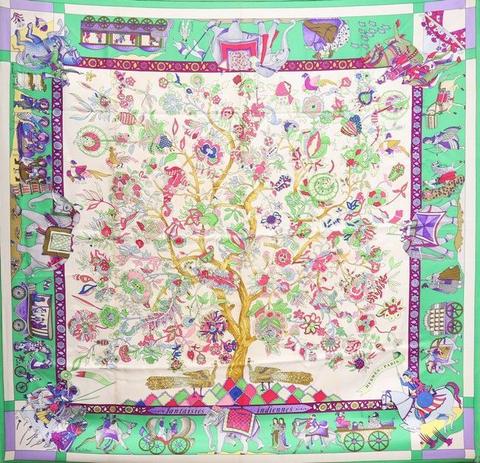Fantaisies indiennes
Designed by Loïc Dubigeon
First edition in 1985
Login or Register to get extra informations (rarity, sku, original prices ...)
Hermes fringed cashmere and silk scarf, 36" x 36"
The border of the “Fantaisies Indiennes” scarf is decorated with figures and animals from the frescoes and murals of the Shekhawati region in northern Rajasthan. These paintings decorated the fortified homes (havelis) of wealthy Marwari merchants who were very successful in the 19th century.
A British influence is also noted with the presence of automobiles, trains and bicycles… They also depict mythological scenes including the rajput legend of Dhola Maru (Indian Romeo and Juliet) who can be seen fleeing on a camel at the bottom left of the scarf.
The center of the scarf depicts a majestic Tree of Life, whose branches form vine-like foliage with lush flowers and exuberant, whimsical leaves. The tree of life symbolizes the process of creation, regenerating life, the eternal rebirth of beings and things. It also represents the cosmic axis linking the subterranean world by its roots to the sky and heavens by its branches, around which the universe is organized.
The tree holds great significance in Buddhism: it is under the Bodhi tree in northern India that Buddha meditated and attained enlightenment or nirvana. For Hindus, the tree’s roots represent Brahma, the god of creation, the trunk is Shiva, the destroyer and transformer, and the branches are Vishnu, the preserver and protector of the universe.
The border of the “Fantaisies Indiennes” scarf is decorated with figures and animals from the frescoes and murals of the Shekhawati region in northern Rajasthan. These paintings decorated the fortified homes (havelis) of wealthy Marwari merchants who were very successful in the 19th century.
A British influence is also noted with the presence of automobiles, trains and bicycles… They also depict mythological scenes including the rajput legend of Dhola Maru (Indian Romeo and Juliet) who can be seen fleeing on a camel at the bottom left of the scarf.
The center of the scarf depicts a majestic Tree of Life, whose branches form vine-like foliage with lush flowers and exuberant, whimsical leaves. The tree of life symbolizes the process of creation, regenerating life, the eternal rebirth of beings and things. It also represents the cosmic axis linking the subterranean world by its roots to the sky and heavens by its branches, around which the universe is organized.
The tree holds great significance in Buddhism: it is under the Bodhi tree in northern India that Buddha meditated and attained enlightenment or nirvana. For Hindus, the tree’s roots represent Brahma, the god of creation, the trunk is Shiva, the destroyer and transformer, and the branches are Vishnu, the preserver and protector of the universe.
Help us enhance Scarf Sage Hermès scarf collection by contributing additional information or higher quality images.





